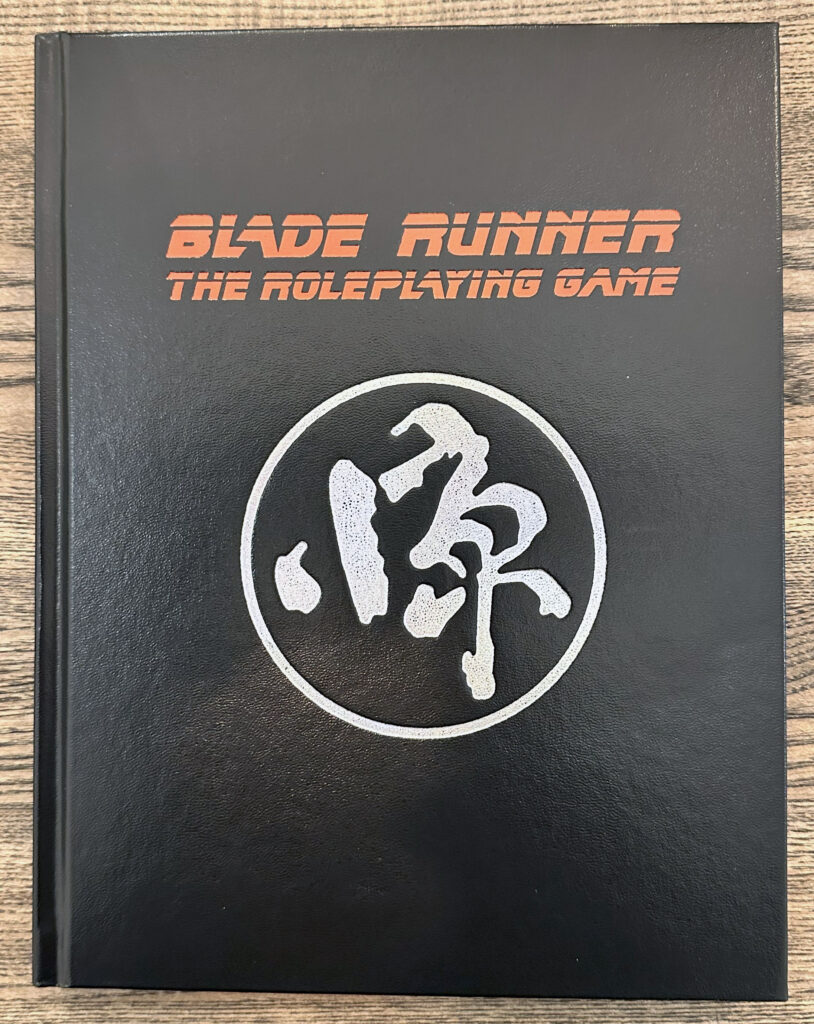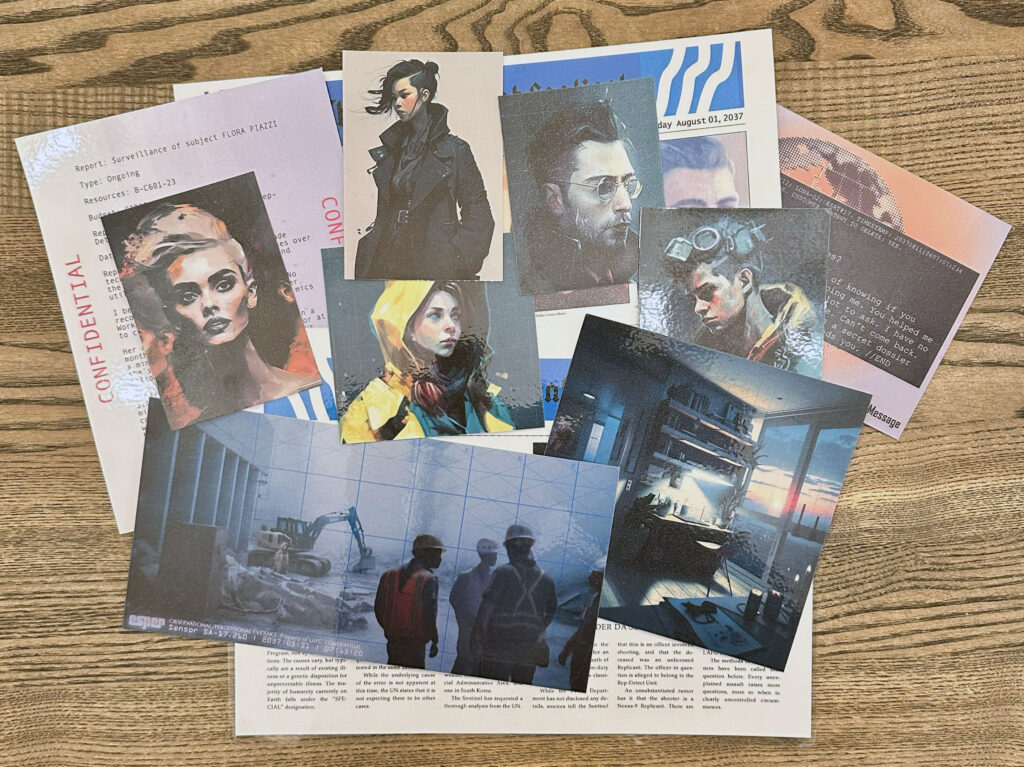I am running two campaigns of Free League’s Blade Runner RPG (2022). We’re eleven sessions in, planning to continue with Fiery Angels once the boxed set releases next month. It’s a good game, everything I hoped from an official Blade Runner game, and with the high quality adventure Electric Dreams in the boxed starter set, even surpasses my expectations.

Game setup
Both group setups felt like experiments. Blade Runner in fiction is a very solo protagonist setup, and I had concerns about how it would work with a group of protagonists. Seeing that I had too many players to fit at a table, I split them into two groups: a detective duo for two players, and two detective duos for four players.
I usually go for 3-5 players at my table, and running with just two felt slightly concerning – it leaves very little downtime for each player, and if the players’ chemistry doesn’t start an immediate fire, I can see how we might be heading to difficult, potentially awkward times. In this case I knew my players well enough to trust that it would work out. The opposite is true for the four player group: will the players have enough screentime? My solution was to set up each Blade Runner with a partner, and then likely we would have just two scenes alternating, not four.
Both campaigns started the same way, with full character creation. I like how vague the book is about some of the background details, like the characters’ recurring dreams and past. Players can make of them what they will, much like the audience of the original movie had to decide for themselves how they read Deckard’s situation. All players really ran with their backgrounds, and added a ton of color and detail to them.
The Year Zero system in Blade Runner
I’ve used Free League’s system in Twilight: 2000, Blade Runner, and Alien roleplaying games. It is a good system, and the designers are very good in adapting it to each instance. The Twilight: 2000 match feels perfect, and with Blade Runner my only issue is the concept of critical hit tables, which feel off in a game that isn’t about combat in any way. In gameplay, they work fine, though, providing quick and decisive violence.
Players like the concept of pushing their rolls, and the system has built-in tension to constantly increase pressure in a session. The valves players have for relieving Stress, in particular, can sometimes feel too game like – one of our Replicant players was really struggling to remain operational with the amount of Stress they had. I’m not sure the balance for Stress is quite right, but I prefer it this way to the alternative of not really ever being an issue.
How it went down
The first game, with just the two detectives, ended up revolving around their back stories. Both had a vague past that we initially struggled to bring to the table, but talking about it, we decided to combine them into a shared recent past. Ultimately, in the so far last episode of the campaign, we played through their shared key memory, and gained a new understanding of both characters. It was amazing.
The other group’s four back stories are more distributed. We’ve managed to prod them all along, but none have come into focus really. Seeing how well the first group worked out, I wish I had requested that the back stories are tied together between the players somehow.
We started both campaigns with the boxed starter set’s Electric Dreams case (adventure). It worked out well both times. The first duo blew through it in two sessions in a satisfying manner, while the other group spent four episodes on the case. The scenes and outcomes were wildly different, because the players paid attention to different things.
Reading the adventure, I was concerned about the amount of scenes that are just lifted from the movies. Would it feel cheap for the players? The opposite proved true: the scenes you can recall from the movies felt genuine, and players appreciated being able to immerse themselves in the world they know. (We did prep by watching both movies just before the game.)
Post game takeaways
Blade Runner cases are structured as investigations, with the detectives following clues from one key scene to the next. Outside of the clue tree is a timeline: things are in motion, and NPCs will take certain actions regardless of what the players do, at specific points of time. This is meant to instil a sense of urgency, and the illusion of a living world. In concept, this works well.
In practice, it’s the one thing in the game I have doubts about. Telling players that there’s a time pressure on things makes them rush, and that leaves too little time for downtime – playing their characters.
You can make that better by insisting that all scenes, including investigate scenes, are played in character and “on screen”: you describe what we see and hear, not just asking to roll an investigative ability and then be given a clue in response.
It’s fun to have the players keep track of how they’re spending their Shifts on the report card, but make sure you also let them know that there is no need to rush. Blade Runner is very much about atmosphere, and you can’t get to that unless you soak in it.
The boxed set’s handouts are great at the table. They make players feel like they’re detectives in a movie, and really bring everyone’s focus on the game. The LA map alone is worth the price – having it laid out on the table really makes everyone think “Blade Runner”. I completed the atmosphere with audio, running both the movie soundtracks and ambient audio (traffic, footsteps, rain, announcements).

Going beyond the boxed set
The problem is that once you go outside the prewritten material, you’re going to want a similar “production quality” or the game will feel off. I spent a lot of effort in designing newspaper handouts, Esper surveillance photos, and the like, for maintaining the illusion. I haven’t done as much prep for a game in years, maybe decades! It was worth it though: to be able to give a fake photograph to the players to study, and then have them make the right conclusions, advancing the story, proved very satisfying for both the players and myself.
Since they were so efficient and we were having fun, we continued the first duo’s game with cases I wrote myself. “Stars My Destination” was about the UN records on humans unfit to leave the Earth and played out over three parts, and “Ceres Calling” returned NPCs from first two cases, paying off player decisions made in early sessions, while following the disintegration of the relationship between the detective partners, thanks to their recent shared past, over two parts. I used the rulebook’s case generator for inspiration, tied things to player character stories, and kept the investigations simple with just two to three core clues required per case.
Leave a Reply